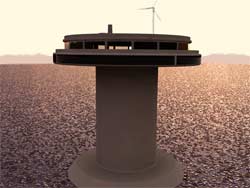The Seasteading Institute is an organization dedicated to creating experimental ocean communities "with diverse social, political, and legal systems."
"Decades from now, those looking back at the start of the century will understand that Seasteading was an obvious step towards encouraging the development of more efficient, practical public-sector models around the world," Thiel said in a statement.
The Institute plans to build a prototype in the San Francisco Bay within the next two years, the first step toward establishing deep-water city-states on the open water and they're bringing an entrepreneurial, DIY mentality to creating oceanic city-states.
The seasteaders want to build their first prototype for a few million dollars, by scaling down and modifying an existing off-shore oil rig design known as a "spar platform."
In essence, the seastead would consist of a reinforced concrete tube with external ballasts at the bottom that could be filled with air or water to raise or lower the living platform on top.
The spar design helps offshore platforms better withstand the onslaught of powerful ocean waves by minimizing the amount of structure that is exposed to their energy.
"You have very little cross-sectional interaction with waves [with] the spar design," Gramlich said.
The primary living space, about 300 square feet per person, would be inside the tube, but the duo envisions the top platform holding buildings, gardens, solar panels, wind turbines and (of course) satellites for internet access.
They believe the outfittings for the seastead will be dependent on the business model, say aquaculture or tourism, that will support it and the number of people aboard.
"We're not trying to pick the one strategy because we think there will be multiple people who want one for multiple reasons," Gramlich said.
"They were sort of like mobile homes. We could move them from one place to another," Donovan said. "People did live on them."
They estimate that it would cost a few hundred million dollars to build a seastead for a few thousand people. With costs that low it might be possible to see constellations of cities springing up, giving people a variety of governmental choices. If misguided policies arose, citizens could simply motor to a new nation.
"You can change your government without having to leave your house,".

